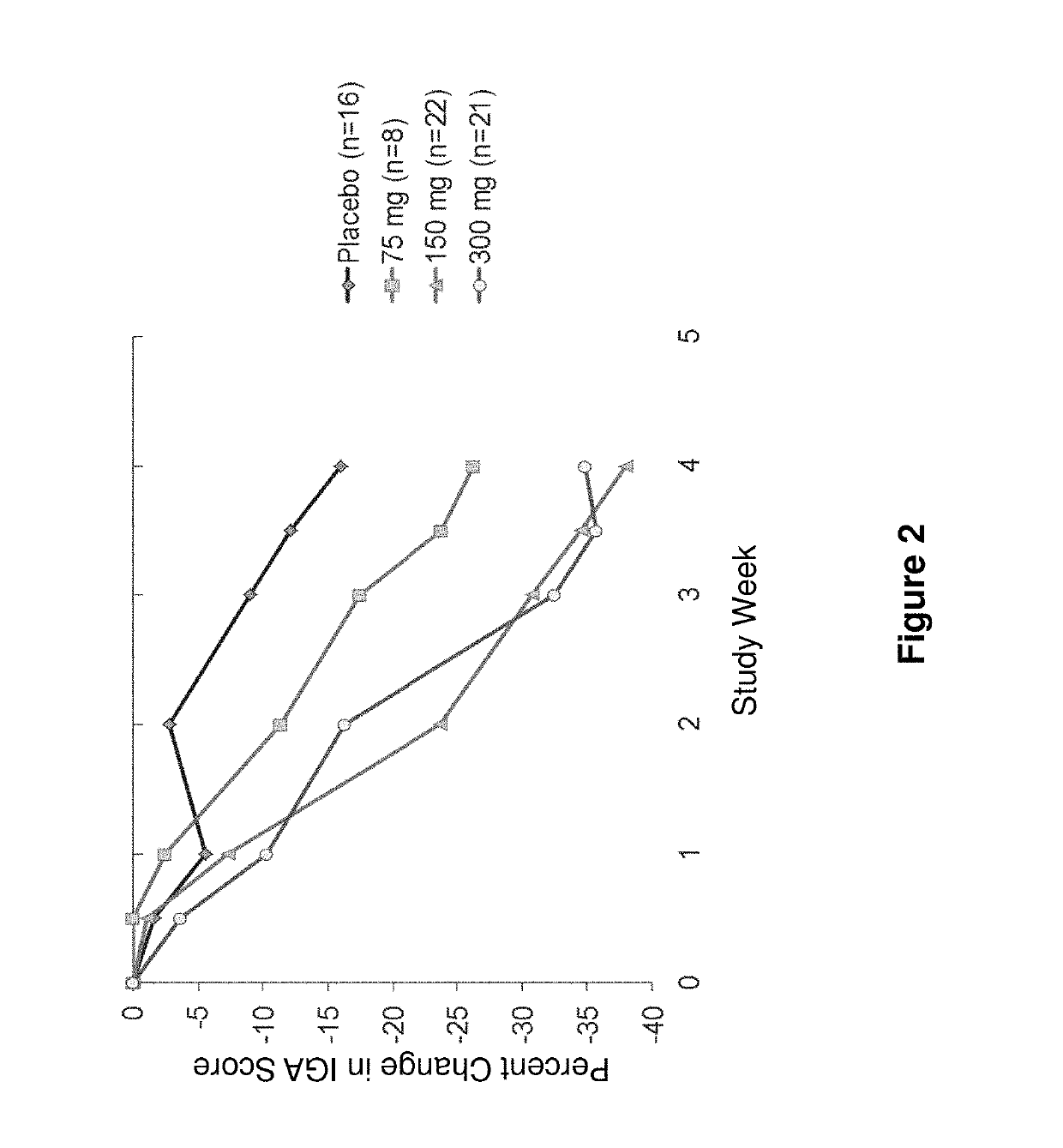Methods for treating skin infection by administering an IL-4R antagonist
a technology of il-4r and skin infection, applied in the direction of antibacterial agents, immunological disorders, antibody medical ingredients, etc., can solve the problems of increasing the risk of skin microbial infections, symptom relief, and inability to treat atopic dermatitis, so as to reduce the susceptibility to skin infection, prevent or ameliorate a skin infection, and reduce the risk of inflammation
- Summary
- Abstract
- Description
- Claims
- Application Information
AI Technical Summary
Benefits of technology
Problems solved by technology
Method used
Image
Examples
example 1
of Patients with Moderate-to-Severe Atopic Dermatitis with Anti-IL-4R Antibody: Analysis of Pooled Phase 1 b Studies
[0119]AD efficacy parameters were measured and pooled for analysis from two separate clinical trials in patients with moderate-to-severe AD. “Study A” was a 12-week, double-blind, randomized, placebo-controlled, sequential ascending dose study to assess the safety and tolerability of administered anti-IL-4R antibody (mAb1) in patients with atopic dermatitis. The treatment period was 4 weeks with patients being followed for 8 weeks after the end of the treatment period. Patients were randomized in a 4:1 ratio to receive mAb1 or placebo in each of the three ascending dose cohorts (75 mg, 150 mg, or 300 mg). The study consisted of a screening period (day −14 to day −3), a treatment period (day 1 through day 29), and a follow-up period (day 29 through day 85). During the treatment period, patients were seen in the clinic once weekly for safety, laboratory and clinical effe...
example 2
se Clinical Trial of Subcutaneously Administered Anti-IL-4R Antibody (mAb1) in Adult Patients with Moderate-to-Severe Atopic Dermatitis
A. STUDY DESIGN
[0165]This study was a 28-week randomized, double-blind, placebo-controlled study of the anti-IL-4R mAb, referred herein as “mAb1”, administered subcutaneously in patients with moderate-to-severe atopic dermatitis. The treatment period was 12 weeks in duration with the patients followed for a further 16 weeks after end of the treatment.
[0166]109 patients were included and randomized in the ratio of 1:1 for the study (54 in placebo and 55 for 300 mg of the antibody). 43 patients (30 in placebo and 13 in 300 mg group) withdrew from the study. Randomization was stratified according to IgE levels (IgE<150 kU / L vs.≥150 kU / L at the screening visit) to test the efficacy of mAb1 in patients with extrinsic or intrinsic form of AD. Patients who met eligibility criteria underwent day 1 / baseline assessments, randomization, and then received 300 mg...
example 3
[0211]Skin barrier function analysis was conducted on samples taken from subjects who participated in clinical trials of mAb1.
Study A
[0212]In ‘Study A’, AD subjects were administered either mAb1 (75, 150 or 300 mg) or placebo, on days 1, 8, 15 and 22 of the study (i.e., four weekly doses). Stratum corneum hydration (SCH; corneometry) and transepidermal water loss (TEWL; evaporimetry) (Vergananini et al 2010, J. Dermatol. Treatment 21: 126-129) were measured at baseline, day 29 (end of treatment) and day 85 (end of study) for a subset of patients in the study.
[0213]The median baseline measurements for SCH and TEWL are summarized in Table 25.
[0214]
TABLE 25Median baseline SCH and TEWLSkin All typePlacebo75 mg150 mg300 mgdosesSCH (a.u.)Lesional1510221311SCH (a.u.)Non-lesional3121312528TEWL (g / m2 / hr)Lesional1559223238TEWL (g / m2 / hr)Non-lesional61971212
[0215]For SCH, the higher the capacitance (a.u.), the more hydrated the skin. The median SCH results for both lesional...
PUM
| Property | Measurement | Unit |
|---|---|---|
| pH | aaaaa | aaaaa |
| pharmaceutical composition | aaaaa | aaaaa |
| dosing frequency | aaaaa | aaaaa |
Abstract
Description
Claims
Application Information
 Login to View More
Login to View More - R&D
- Intellectual Property
- Life Sciences
- Materials
- Tech Scout
- Unparalleled Data Quality
- Higher Quality Content
- 60% Fewer Hallucinations
Browse by: Latest US Patents, China's latest patents, Technical Efficacy Thesaurus, Application Domain, Technology Topic, Popular Technical Reports.
© 2025 PatSnap. All rights reserved.Legal|Privacy policy|Modern Slavery Act Transparency Statement|Sitemap|About US| Contact US: help@patsnap.com



